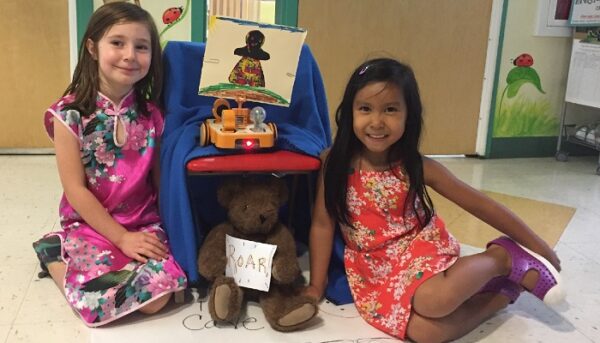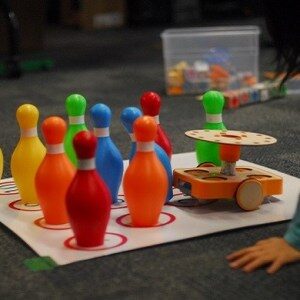Recovering from Learning Loss and Promoting Social-Emotional Learning with KIBO
The recent federal stimulus program signed March 11, the American Rescue Plan, provides $122 billion in aid to K-12 schools. Provisions in the law guarantee that at least 20% of this funding must be spent on programs to help students recover from learning loss during this challenging past year. These funds will support interventions like extended school hours and summer enrichment programs. Other portions of the stimulus will support safe school re-opening.
This is a challenging but exciting time for PreK-2 students and their teachers. We know young children learn best working together with their teachers, in collaboration with their peers, and using hands-on manipulatives. An age-appropriate, cross-curricular tool like KIBO can help students re-engage with in-person learning, practice SEL skills like collaboration and teamwork, and recover lost ground in math, literacy, and more with cross-curricular STEAM lessons.
Recovering Lost learning
KIBO is a hands-on, screen-free robot kit designed to introduce coding, engineering, and computational thinking in Pre-K through 2nd grade. With computational thinking, you model the problem, break it down into smaller sequential steps, invent solutions, and test them out. The term “computational thinking” grew out of work in the 1980s by Seymour Papert, a pioneer in teaching children to create with code. When children use code to create algorithms (a series of ordered steps to solve a problem) they develop their sequencing ability: a foundational skill for reading and mathematics.
But in early childhood, organizations like NAEYC agree that it’s also important engage with coding and technology concepts by embedding them in the context of familiar subjects. That’s why although KIBO’s curriculum is standards-aligned in computer science and engineering, our lessons also support deep cross-curricular connections to science, ELA, math, and social studies.
These cross-curricular connections are developmentally appropriate. But they have another benefit as we consider how to create engaging learning experiences that also address learning loss. As we focus on ensuring our students meet ELA and math expectations, projects with KIBO can play an important role. Children can use KIBO as a tool to explore these fundamental subjects.
 Storytelling with KIBO: Foundational ELA standards in literature ask students to recount the plot of a story in their own words, or to describe the main characters. Students can engage more deeply with classroom literature by creating a floor map to represent the story space, and programming KIBO to re-tell, re- imagine, and re-enact a scene from the book. In creating this KIBO character and story, students develop foundational reading comprehension skills, learn about setting in narrative, and practice putting story events in sequence. They can even read and repeat lines from the book to narrate KIBO’s movements live. Get this activity, and more, in our free Maps, Measurement, and Make-Believe activity booklet.
Storytelling with KIBO: Foundational ELA standards in literature ask students to recount the plot of a story in their own words, or to describe the main characters. Students can engage more deeply with classroom literature by creating a floor map to represent the story space, and programming KIBO to re-tell, re- imagine, and re-enact a scene from the book. In creating this KIBO character and story, students develop foundational reading comprehension skills, learn about setting in narrative, and practice putting story events in sequence. They can even read and repeat lines from the book to narrate KIBO’s movements live. Get this activity, and more, in our free Maps, Measurement, and Make-Believe activity booklet.
 Math with KIBO: Estimation, prediction, and conversion between standard and non-standard units of measurement are all activities that support development of foundational math skills in early childhood. With KIBO, we can practice these skills in the context of a fun classroom game: KIBO Bowling! Set up some plastic pins at one end of the room, and KIBO at the other. How many “forward” commands will KIBO need to reach the pins? How many pins did KIBO knock down, and how many are left? KIBO’s physical movement in the classroom allows children to engage with math concepts concretely and playfully. Download this KIBO Bowling math activity.
Math with KIBO: Estimation, prediction, and conversion between standard and non-standard units of measurement are all activities that support development of foundational math skills in early childhood. With KIBO, we can practice these skills in the context of a fun classroom game: KIBO Bowling! Set up some plastic pins at one end of the room, and KIBO at the other. How many “forward” commands will KIBO need to reach the pins? How many pins did KIBO knock down, and how many are left? KIBO’s physical movement in the classroom allows children to engage with math concepts concretely and playfully. Download this KIBO Bowling math activity.
Welcoming children back to in-person group work through SEL
Engaging, cross-curricular STEM activities allow us to practice core math and literacy skills in a fun, developmentally appropriate context. But what about addressing our children’s difficult transition back to in-person, collaborative work? How do we support students’ social-emotional needs during this challenging time?
Social/Emotional Learning is a foundation of KIBO’s curriculum. Our curriculum draws on the pioneering work of our co-founder, Dr. Marina Bers, who developed the Positive Technological Development (PTD) framework for designing technology experiences in early childhood. PTD is an interdisciplinary approach that describes how positive childhood behaviors can be supported by educational programs that use new educational technologies, such as robotics.
With KIBO and the PTD framework supporting our curriculum, children work in small groups to enhance communication and collaboration skills. They take on different roles in group work, allowing students to share in each other’s expertise. They come together in facilitated circle meetings to discuss aspects of the work that were particularly challenging and to get ideas from each other on how to solve problems. These collaborative and communicative skills are the very ones that need explicit practice as children return to in-person group work.
What does this look like in a lesson? We can decorate KIBO to turn it into a character, or a family member, or a friend, and can allow children to work through social situations using KIBO. We can even create “role play” lessons with KIBO. For example, we could decorate KIBO as a child who is new to the school, create a program where KIBO drives into the circle and shakes (representing being nervous). Children could practice welcoming the new friend into the class. Download a lesson plan we shared for Hour of Code, about creating a KIBO program to express a feeling.
Aside from communication and collaboration, we also need to encourage persistence and “grit” as critical SEL skills for young children. Working with robotics and coding means engaging with the engineering design process. This process encourages children to identify a problem, imagine and plan a solution, build and test their creation, and share their work with peers. In this process, things won’t always work as intended – ask any engineer! The process is set up to expect students to test, fix, and debug their work, so students focus on continually making changes and improvements rather than on being right or wrong – a “growth mindset.”
Returning to safe in-person learning will be both exciting and difficult, for teachers and for students. Addressing learning loss and complex social-emotional challenges will require a range of creative approaches. Developmentally appropriate STEAM projects with KIBO can help you meet these challenges, and we look forward to supporting you on this journey.
Learn the 6 Key Benefits of Using Robotics with Your Youngest Students!
![]() Introduce coding and robotics into your early childhood classrooms – in a fun and playful way!
Introduce coding and robotics into your early childhood classrooms – in a fun and playful way!



















